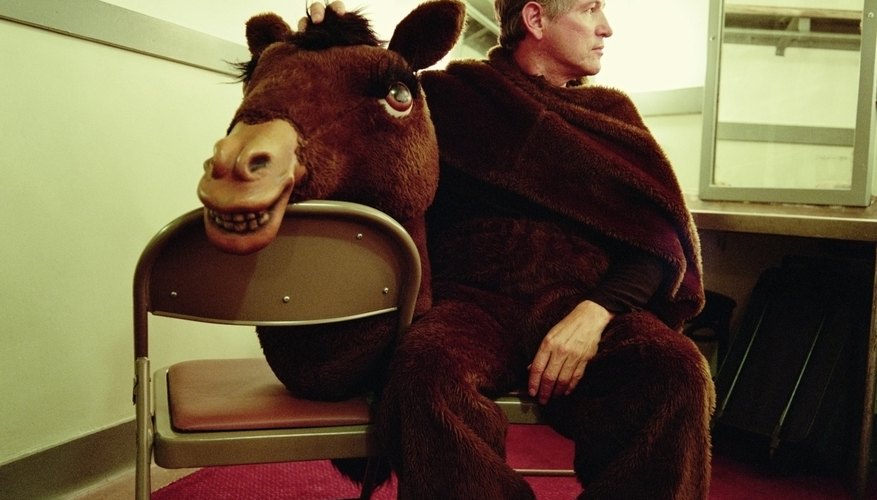The history of pantomime characters in theatre dates back to the Middle Ages and includes both human and animal characters, such as the horse. One of the first theatrical roles that Charlie Chaplin played was the front end of a pantomime horse. The pantomime horse costume is, of course, a two-person outfit that requires one individual to be the head of the horse and the other person to be the horse's backside. While there are many companies that make or rent these costumes for a fee, you can make one at home at a greatly reduced cost.
- The history of pantomime characters in theatre dates back to the Middle Ages and includes both human and animal characters, such as the horse.
- The pantomime horse costume is, of course, a two-person outfit that requires one individual to be the head of the horse and the other person to be the horse's backside.
Select a pair of trousers belonging to the largest person that will be wearing the costume and lay them on the back of doubled fake fur. Use a marker and outline the trousers on the fur approximately 3 inches from the pant seams. This will allow both people enough room to move around in the trousers and allow the person in the back of the costume to bend over. Draw two patterns for two pairs of trousers using the same procedure.
Cut out the two fur trousers patterns with scissors.
Sew seams along the outer and inner edges of the trousers with a sewing machine, making them seam about 1/2 inch on each side.
Connect clip on suspenders to the trousers.
Measure the head of the person that will be wearing the horse's head. Measure the height of the head, as well as around the top of the head.
Shape chicken wire to form the horse's head. Use your measurements to construct the chicken wire, adding at least 1 inch to both measurements to allow the person to move their head inside of the mask. Use wire cutters to trim any excess.
- Cut out the two fur trousers patterns with scissors.
- Shape chicken wire to form the horse's head.
Mix one part glue with one part water in a bucket and stir thoroughly.
Tear newspaper into long strips and dip each strand of newspaper into the water-glue mixture.
Cover the chicken wire completely with the newspaper strips. Apply at least three layers of newspaper strips to the chicken wire and allow the strips to dry thoroughly. This make take a few days.
- Mix one part glue with one part water in a bucket and stir thoroughly.
- Apply at least three layers of newspaper strips to the chicken wire and allow the strips to dry thoroughly.
Cut the newspaper across the head behind the ears with a utility knife. Cut the newspaper mould completely separating the front of the head from the back and remove the newspaper mould from the chicken wire. Once the chicken wire is removed, glue the two sections of the head back together with craft glue and allow them to dry.
Cut out eye holes and a section of the mouth for breathing.
Paint the horse's head with acrylic paints.
Add long strands of fake hair to the back of the horse's head for the mane.
Measure the width of the person that will be in the back end of the costume and the shoulders of the person that will be in the front. Use the larger of the two measurements, plus 2 inches for movement room. Then measure the height of the person that will be in the front, from the shoulders to just below the knees, as well as the length of the two people standing together, with the person in the back of the costume bent over. Add a few inches to both measurements for movement room.
- Cut out eye holes and a section of the mouth for breathing.
- Then measure the height of the person that will be in the front, from the shoulders to just below the knees, as well as the length of the two people standing together, with the person in the back of the costume bent over.
Lay out a doubled piece of fur on a flat surface, with the fabric turned inside out. Use your measurements and a marker to draw an outline for the body of the costume.
Cut the material out with scissors and then use straight pins to pin the edges together.
Sew the edges of the fur material together, being careful to leave an opening for the head of the person at the front. Sew a hem at the bottom of the body as well.
Cut a strip of fur for the tail and sew it to the rear of the costume.
